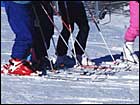|
Buying the boot
|
 |
December 13, 2001: 12:29 p.m. ET
Fit is first and foremost
By Sarah Max
|
NEW YORK (CNN/Money) - Skiing or boarding in the wrong boots is the equivalent of driving a car with the wrong tires. Boots dictate your performance, your comfort and ultimately whether you have a great day on the slopes or one spent pining for the chalet. So if you're going to spend serious money on any piece of equipment, spend it on your boots.
Although fit is more crucial with ski boots than with snowboard boots, getting the right fit is the most important aspect of buying a boot. Every brand of boot is likely to fit your foot differently. Nordica, for example, typically makes its boots wider, while Lange has a reputation for an extremely snug fit. For this reason, you'll want to try on several brands of boots before you buy. "It's key to find a boot that fits out of the box to begin with so you don't have to do a lot of tinkering," said Allen St. John, author of Skiing for Dummies and contributing editor to Skiing magazine.
Unlike hiking boots or running shoes, where extra wiggle room is a good thing, ski and boarding boots should fit snugly and be worn with one thin sock. "It's a common mistake to buy boots too big," said Jim Graham general manager for Princeton Ski Shops. "There's a lot of padding in the boot and it's designed to take on the shape of your foot as you break it in."
A good boot fitter will remove the lining and ask you to put your foot in the shell. When your toe is touching the front of the boot, there should be no more than an inch between your heel and the back of the boot. If a boot passes that test, you should try on the boot with the lining and buckle it up. Your toes should touch the tip of the boot when you're standing straight up but move back when you squat into a skiing or riding stance.
A boot's stiffness or "flex" is another key consideration. How stiff you want your boots depends partly on your skiing ability. Expert skiers have traditionally favored stiffer boots because they respond to the slightest movement. Beginners, on the other hand, want a softer boot because it's more forgiving of poor technique. (These rules apply to snowboarders, though some freestyle boarders like more pliant boots.)
Your weight and strength also determine how stiff a boot should be. When you buckle (or lace) a boot you should be able to bend your knees without having to lift your heels off the ground. Remember that it's going to be colder on the hill, and the boot will be even stiffer. If you can't make the boot flex in the shop you need a softer boot.
"If you plan on being at the mountain less than 15 times, consider a less expensive and softer boot that will take less time to break in," says Jeremy Kent, a former ski and boarding instructor who now works for Fuse Sports Marketing. "In the case of snowboarding, beginners should treat themselves to softer boots."
You can expect to pay between $200 and $500 for boots, depending on how stiff you go. The stiffest boot in the store is usually the most expensive boot, while the cheapest boot will probably be the softest. So be honest about your ability and don't pay more than you need to for a stiff boot just because you think it's the best. Unlike cars, where a higher sticker price usually guarantees a smoother ride, a boot's performance depends entirely on the driver.
A final word on footbeds
You'll probably hear about footbeds when you're out shopping for boots. Fans of these special insoles say they improve the fit of a boot and in turn boost performance. If get on the mountain only a few times a year, don't have problems with your boots and don't want to spend the extra money, you can probably pass on the fancy footbeds. If your boots are not quite perfect, mass-made footbeds are a $30 solution. If you have serious fit issues, custom footbeds could be the cure, but they start at about $100 a pair. 
|
|
|
|
|
|

|

